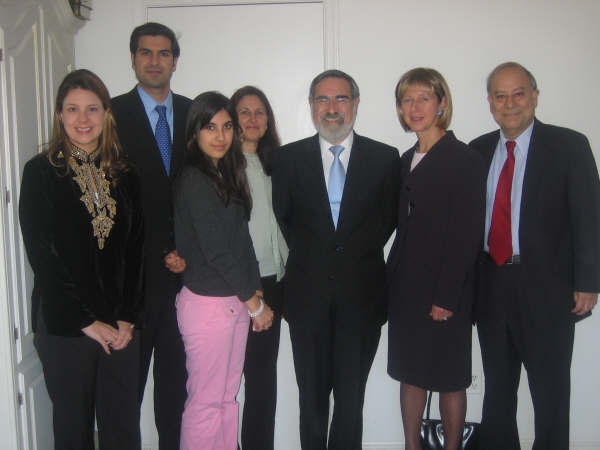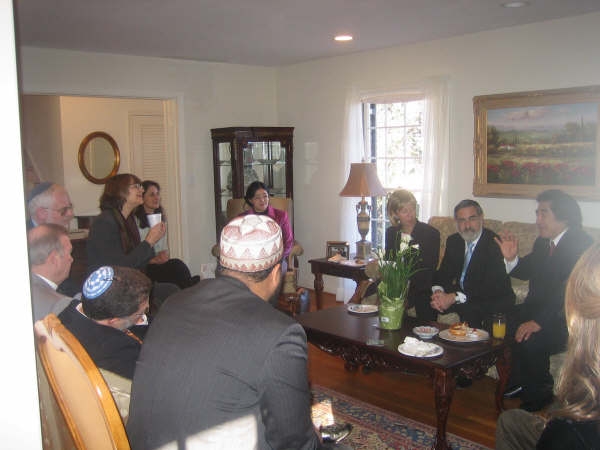Unprecedented
Visit of Chief Rabbi UK to Home
of Muslim Scholar
By Melody Fox
Washington, DC
 The
Ahmed family, Rabbi Sacks and Lady Sacks
The
Ahmed family, Rabbi Sacks and Lady Sacks
|
The above headline almost
seems lifted from some fictitious interfaith newspaper,
because such an event rarely, if ever, has occurred.
But on the cold but crisp and clear autumn morning
after Thanksgiving Day, these words came to life
at the home of Professor Akbar Ahmed. Here, on
November 25th, an intimate gathering became a
historic occasion and a living celebration of
thanksgiving for friendships forged over seemingly
drastic differences.
Ahmed, the Ibn Khaldun Chair of Islamic Studies
at Washington D.C.’s American University,
hosted a breakfast at his family’s home
in Bethesda, Maryland in honor of Sir Jonathan
Sacks, the Chief Rabbi of the United Kingdom.
Along with his wife, Rabbi Sacks was visiting
the Ahmed home for the first time. The other distinguished
guests included Bishop John Chane, the eighth
Bishop of Washington and his wife; Rabbi Bruce
Lustig, Senior Rabbi of Washington Hebrew Congregation
and his family; Imam Magid of the ADAMS mosque;
Dr. Haru Haisa Handa, a Japanese artist, Shinto
priest, and Chancellor of the University of Cambodia;
Dean Nanette Levinson of American University’s
School of International Service; and Rabbi Kenneth
Cohen of American University.
Rabbi Sacks is the leader of the Hebrew congregations
of the United Kingdom, and is known and respected
worldwide for his enlightened and forward-thinking
approach to faith in the modern world. He stopped
at his Muslim friend’s house in the midst
of a packed schedule of lectures and speeches
that would take him to New York City later that
day. When he and his wife arrived, they sat down
with Professor Ahmed and his family in the living
room where the Ahmeds work, watch television,
and relax. Rabbi Sacks blessed the family using
the words of Abraham, the patriarch loved and
revered by both Jews and Muslims. He called for
wisdom, strength, and patience to continue the
urgently necessary, yet difficult and even dangerous
work that encouraging tolerance and bridge-building
can be in times of conflict and fear. Although
this is a time when the Israeli-Palestinian conflict
worsens daily and passions and hate run high between
Muslims and Jews, the sight of Akbar Ahmed and
Rabbi Sacks praying together for peace provides
a strong symbol of hope for the future. Rabbi
Sacks presented his latest book, “To Heal
a Fractured World” to the Ahmed family,
inscribing it: “To Akbar and family –
a true leader of compassion and courage, in cherished
friendship and great admiration, with blessings,
Jonathan Sacks.”
Ahmed thanked his guests for visiting his home
and sharing a meal with his family; culturally
a highly personal and significant event. These
leaders and scholars were not participating in
another sterilized and choreographed lecture on
campus or shaking hands for the cameras, but had
privately come to spend time together on a holiday
normally spent with family recovering from the
previous day’s Thanksgiving meal. And here,
at the Ahmed home, the guests were doing just
that - spending their holiday together as family.
 Clockwise from top
right: Lady Sacks, Rabbi Sacks, Dr. Handa,
Imam Magid, Rabbi Lustig, Bishop Chane,
Rabbi Cohen, Dean Nane tte Levinson
Clockwise from top
right: Lady Sacks, Rabbi Sacks, Dr. Handa,
Imam Magid, Rabbi Lustig, Bishop Chane,
Rabbi Cohen, Dean Nane tte Levinson
|
The guests enjoyed a delicious
and all kosher breakfast of bagels, lox, cheese
and fruits. They ate together in the sitting room,
seated randomly in a casual “interfaith
roundtable”: Dr. Honda next to Rabbi Sacks,
Rabbi Lustig next to Bishop Chane, Imam Magid
to his right. The conversation flowed –
a highlight was the positive and successful discussion
between Dr. Handa, a senior Shinto priest, and
Rabbi Sacks about the common bonds that exist
between the Abrahamic and Shinto religious traditions.
Aware of the at-times incomprehensible nature
of their close friendship to others, Bishop Chane,
Rabbi Lustig, and Professor Ahmed discussed the
background of how they met and became friends
(Professor Ahmed was seated next to Amy, Rabbi
Lustig’s wife, at a dinner one night. Amy
then introduced Ahmed to her husband, and organized
a dinner for the three at their home. The three
stayed talking late into the night about what
they could accomplish together, fueled by the
flame born from encountering instant kindred spirits).
Each has faced opposition from their congregations,
colleagues, and the general public – Bishop
Chane being called a “Muslim Bishop”;
and all three receiving hate mail and threats.
Rabbi Sacks lauded the three “spiritual
musketeers,” as they are also sometimes
called, for persevering in their work in spite
of the difficulties they face. (He admitted to
very nearly losing his own job over his book,
“The Dignity of Difference”). Rabbi
Sacks praised them for showing different people
how to “see each other” and become
friends, referencing the biblical story of Abraham’s
sons, Ishmael and Isaac, who were driven apart
when Ishmael and his mother were expelled into
the desert. Many Jews and Muslims trace the roots
of their historical antagonism to this ancient
fraternal conflict, overlooking the fact that
the story ends with reconciliation and forgiveness.
After their separation, the two brothers peacefully
came together when their father died about seventy
years later (Genesis 25:9).
Bishop Chane invited Rabbi Sacks to join him in
residence at Washington D.C.’s National
Cathedral, where along with Rabbi Lustig and Professor
Ahmed he has formed an Abrahamic Roundtable that
meets regularly. American University’s Dean
Levinson emphasized the importance of creating
global educational ties and invited Rabbi Sacks
to speak at AU.
After a morning of lively conversation, new ties
formed and friendships strengthened, Rabbi Sacks
drew the gathering to a thoughtful close with
a story about the symbolism of “two hands
joining”. In the Hebrew language, there
are many words that carry a double meaning. One
of these words is “fourteen”, which
can also mean “friendship”. As Rabbi
Sacks explained, in each of our hands, there are
fourteen joints. Join two hands together, and
twenty-eight joints are linked. The word for “twenty-eight”
can also mean “strength”. Thus, out
of two hands joined in friendship, comes true
strength.
Adding to this powerful metaphor, Rabbi Sacks
offered a truism summarizing the theme that continues
to unite these scholars and leaders of different
religions, cultures, and nationalities together,
saying: “If we were all so different, we
could not communicate. If we were all the same,
we would have nothing to say to each other”.
As a young American committed to promoting interfaith
dialogue and bridge-building, being part of this
historic gathering was moving and inspiring to
me on a level rarely felt before. Too often, people
segregate themselves into safe worlds neatly organized
by religion, color, nationality, or whatever other
category is available. Stepping out of the bounds
of the familiar to encounter someone different
than ourselves on a deeper level often has the
surprising result of showing us that the “other”
is much closer and familiar than we thought. And
opening ourselves to partnership has the potential
to elevate our hearts and minds to accomplish
far more than we could alone and limited to one
world. I believe that the constant encounter with
the other and the open embrace of diversity is
what makes America so great, and hope that events
similar to this gathering will be repeated across
the world to the benefit of us all.
------------------------------------------------------------------------------

